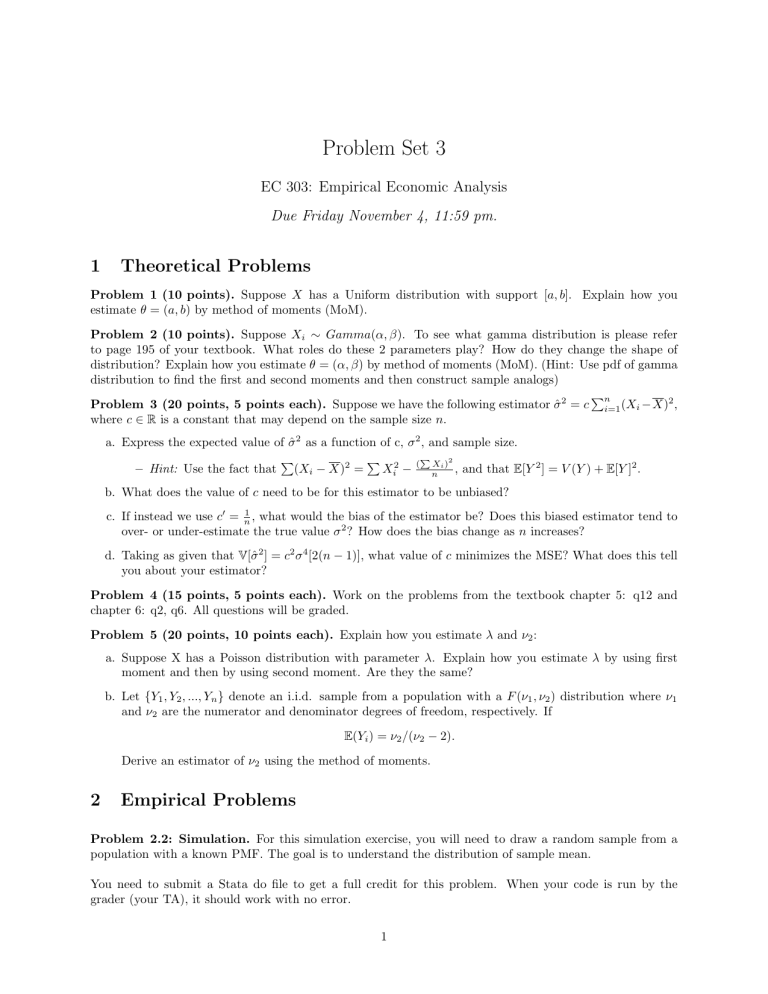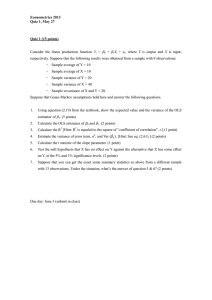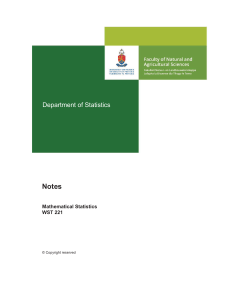
Problem Set 3
EC 303: Empirical Economic Analysis
Due Friday November 4, 11:59 pm.
1
Theoretical Problems
Problem 1 (10 points). Suppose X has a Uniform distribution with support [a, b]. Explain how you
estimate ✓ = (a, b) by method of moments (MoM).
Problem 2 (10 points). Suppose Xi ⇠ Gamma(↵, ). To see what gamma distribution is please refer
to page 195 of your textbook. What roles do these 2 parameters play? How do they change the shape of
distribution? Explain how you estimate ✓ = (↵, ) by method of moments (MoM). (Hint: Use pdf of gamma
distribution to find the first and second moments and then construct sample analogs)
Pn
Problem 3 (20 points, 5 points each). Suppose we have the following estimator ˆ 2 = c i=1 (Xi X)2 ,
where c 2 R is a constant that may depend on the sample size n.
a. Express the expected value of ˆ 2 as a function of c,
P
P 2
– Hint: Use the fact that (Xi X)2 =
Xi
2
(
, and sample size.
P
X i )2
,
n
and that E[Y 2 ] = V (Y ) + E[Y ]2 .
b. What does the value of c need to be for this estimator to be unbiased?
c. If instead we use c0 = n1 , what would the bias of the estimator be? Does this biased estimator tend to
over- or under-estimate the true value 2 ? How does the bias change as n increases?
d. Taking as given that V[ˆ 2 ] = c2
you about your estimator?
4
[2(n
1)], what value of c minimizes the MSE? What does this tell
Problem 4 (15 points, 5 points each). Work on the problems from the textbook chapter 5: q12 and
chapter 6: q2, q6. All questions will be graded.
Problem 5 (20 points, 10 points each). Explain how you estimate
and ⌫2 :
a. Suppose X has a Poisson distribution with parameter . Explain how you estimate
moment and then by using second moment. Are they the same?
by using first
b. Let {Y1 , Y2 , ..., Yn } denote an i.i.d. sample from a population with a F (⌫1 , ⌫2 ) distribution where ⌫1
and ⌫2 are the numerator and denominator degrees of freedom, respectively. If
E(Yi ) = ⌫2 /(⌫2
2).
Derive an estimator of ⌫2 using the method of moments.
2
Empirical Problems
Problem 2.2: Simulation. For this simulation exercise, you will need to draw a random sample from a
population with a known PMF. The goal is to understand the distribution of sample mean.
You need to submit a Stata do file to get a full credit for this problem. When your code is run by the
grader (your TA), it should work with no error.
1
a. (5 points) Set number of observations in your data set to 10 and number of samples to 500.
b. (5 points) Let X be a discrete RV and suppose in the population it can take values 10, 20, 30, 40, and 50 with
equal probabilities i.e. P (X = 10) = P (X = 20) = P (X = 30) = P (X = 40) = P (X = 50) = .2 Get a
random sample of size 10 from the population described. Do it 500 times.
c. (5 points) For each sample you get above (500 samples total) calculate the sample mean and sample variance.
d. (5 points) How does the distribution of sample mean look like? Draw a histogram. What about the distribution
of sample variance? Remember we are looking at the values of sample means and sample variances
over 500 samples.
e. (5 points) Follow the same steps above for sample sizes 50, 100, 500, and number of samples 50,100, 500. Interpret
your results. Conceptually, sample variance and variance of sample mean are two di↵erent things. Make
sure you understand this. What happens to sample variance as sample size gets larger? What happens
to the variance of sample mean as sample size gets larger? Comment.
2







